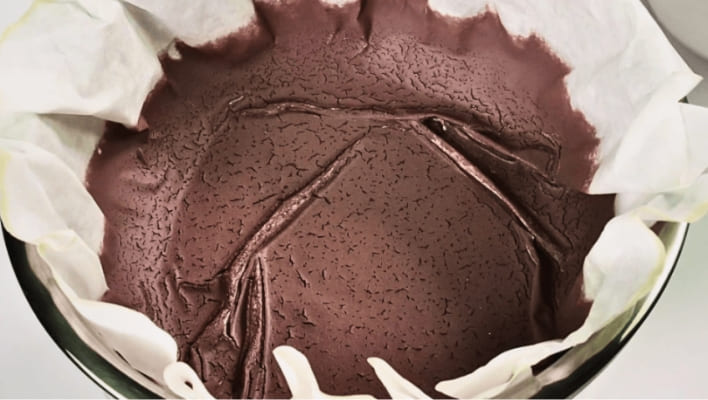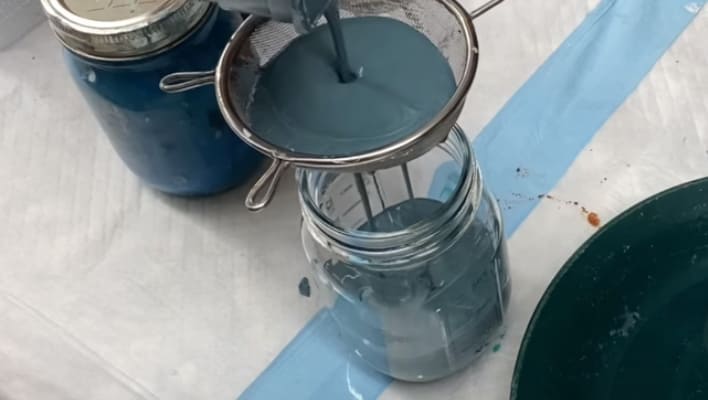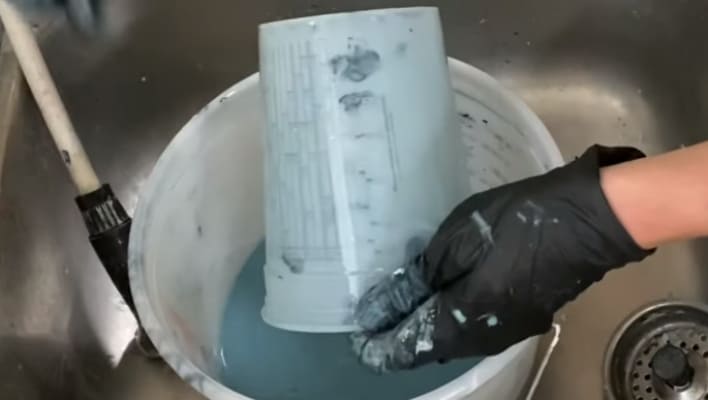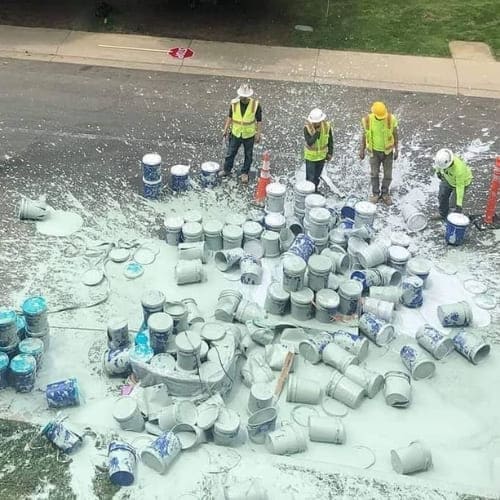The vibrant colors, ease of use, and versatility of acrylic paint make it a popular choice for artists and painters alike. Plus, the acrylic market is experiencing a steady annual growth rate of approximately 4.5%, indicating its sustained appeal. However, it is important to address the environmental implications associated with the disposal of acrylic paint water.
We often need to decide how to dispose of acrylic paint water when painting with acrylic paint as a painter or artist.
A lot of YouTube videos can overwhelm with so many approaches. However, when disposing of acrylic paint water, it’s important to follow environmentally friendly practices to minimize harm to the ecosystem. Our disposal techniques prioritize convenience and affordability rather than complex, time-consuming methods. So here, I offer practical, easy-to-implement paint disposable solutions that work best for you.

Table of Contents
- How to dispose of paint water
- 1: Settling / Drain screen
- 2: Evaporation:
- 3: Solidification:
- 4: Filtering and Disposal:
- 5: Water Treatment Facilities:
- 6; Cleaning Equipment and Brushes:
- How to Dispose of Acrylic Paint Properly:
- Dispose of Non-Toxic Acrylic Paint:
- How do I clean acrylic paint water?
- How to Dispose of Toxic Acrylic Paint: Safely and Responsibly
- is acrylic paint bad for the environment?
- Is it safe to wash acrylic paint down the sink?
- Conclusion:
- FAQS On How to dispose of acrylic paint water
- Q: How should I dispose of acrylic paint water in the UK or USA?
- Q: Can acrylic water be washed away easily?
- q: How should I store acrylic paint to keep it in good condition?
- Q: What are the ways to reuse dried acrylic paint?
- Q: Is acrylic paint recyclable?
- Q: How can I dispose of excess water-based paint properly?
- Q: Can you flush paint water down the toilet?
How to dispose of paint water
Acrylic paint is a water-based product containing additives, synthetic polymers, and pigments. Although acrylic paint is less harmful than oil-based paint, it still poses a threat to the environment if it is not disposed of properly. Pigments and paint residue can contaminate water bodies and harm aquatic life. Therefore, awareness and responsible practices are key to mitigating any negative impact on the environment.
Now let’s look at some affordable solutions for disposing of acrylic paint water.

1: Settling / Drain screen
To dispose of acrylic paint water effectively, start by allowing it to settle and separate. Place the container of paint water in a well-ventilated area and let the paint particles collect at the bottom. Once settled, transfer the clean water to a new container.
For the added step of removing acrylic solid paint particles, utilize a drain screen. These inexpensive screens can be found at dollar stores and placed over the sink drain to catch solids. Clean the screen after each use, ensuring continued effectiveness.
Combining these methods provides a simple and convenient way to dispose of acrylic paint water while minimizing environmental impact.
2: Evaporation:
Evaporation is another eco-friendly method of disposing of acrylic paint water. Put the paint water in a shallow container, such as a disposable pie plate or tray, and place it away from direct sunlight in a well-ventilated area. Solid acrylic paint residue will be left behind after the water evaporates. Let the paint residue completely dry, then scrape it away with regular household waste.
3: Solidification:

If you prefer an easier and more convenient way of disposing of acrylic paint water, you can solidify it before disposing of it. Here are two ways!
a: Absorbent Materials:
Pour acrylic paint water into a container filled with absorbent materials like cat litter, sawdust, or shredded paper. As the liquid is absorbed, a solid mass forms. Allow it to dry completely before discarding the solidified material in your regular trash. Be sure to check your local regulations before disposing of solid waste.
B: Drying Agents:
Acrylic paint disposal can be accomplished with commercial drying agents. In just a few minutes, these products accelerate the drying process, solidifying the paint water.
4: Filtering and Disposal:

It is a responsible option to filter acrylic paint water containing excessive paint particles before disposal. You can strain the water using fine-mesh paint filters, coffee filters, or cheesecloth. Filtered water can be disposed of through methods like settling, evaporation, or solidification as mentioned above. Now, filtered paint particles can be thrown away as regular trash.
5: Water Treatment Facilities:
When disposing of acrylic paint water, it’s a good idea to contact your local water treatment facility. These facilities are equipped and have the expertise to treat paint-contaminated water in a safe way. Their staff will provide you with guidance on how to dispose of acrylic paint water in an environmentally safe manner.
6; Cleaning Equipment and Brushes:

Cleaning brushes and other painting tools is equally as important as disposing of acrylic paint water. Fill a separate water container with water for rinsing brushes and equipment. The paint particles should settle at the bottom, then carefully drain the water to be disposed of. You can solidify leftover paint residues using cat litter or sawdust and dispose of them as appropriate.
How to Dispose of Acrylic Paint Properly:
Putting acrylic paint in regular trash bins or mixing it with other household waste can lead to chemical contamination in landfills. Don’t worry! I am here to tell you the correct methods of disposing of acrylic paint, so that we can minimize its environmental impact.
Dispose of Non-Toxic Acrylic Paint:
Painters and crafters often consider acrylic paint to be a safe and non-toxic option. However, the environmental impact of acrylic paint varies. Although some acrylic paints are labeled as non-toxic, they may still release harmful chemicals into the environment over time as a result of the process by which they are manufactured and sold.
The following section discusses how to safely dispose of non-toxic acrylic paint, ensuring that we are aware of the potential risks of some acrylic products and taking the appropriate measures to prevent them from becoming a toxic waste.
Useful Resource: Check out the article on whether acrylic paint is flammable when dry or not.
Check the Paint Label:
It’s extremely important to confirm that non-toxic acrylic paint is actually non-toxic before disposing of it. Look for any instructions or symbols indicating that the paint can be disposed of in regular waste on the label or packaging. If the paint doesn’t have clear labeling about how to get rid of acrylic paint, then consult the manufacturer.
Dry Out the Paint:
It is easy to dispose of non-toxic acrylic paint by letting it dry completely. To begin with, remove excess paint from brushes, palettes, or containers. Place the paint away from direct sunlight in a well-ventilated area. It may take a few days to dry the paint, depending on its thickness. Upon drying completely, you can dispose of it in your regular waste bin.
Solidify with an Absorbent Material:
An absorbent material can solidify non-toxic acrylic paint. Add cat litter, sawdust, or shredded newspaper to the paint container to absorb the paint. After that, the absorbent material should be thoroughly mixed with the liquid paint to ensure that it absorbs the paint. Now, let it dry completely until it forms a solid mass. When it solidifies, throw it away as normal.
Donate or Share:
It is a good idea to donate or share non-toxic acrylic paint if you have leftovers that are still usable. You might be able to get free paint for your school, art organization, community center, or a fellow artist’s project. It reduces waste and promotes creativity within your community when you share your paint.
Recycling Programs:

Non-toxic acrylic paint may be recycled in some areas. Check your local recycling centers, waste management facilities, or community recycling events for non-toxic acrylic paint acceptance. Plus, environmentally friendly programs ensure paint recycling or disposal properly.
Proper Brush Cleaning:
Brush cleaning isn’t directly related to disposal, but it is important to follow proper brush cleaning techniques. Brushes used to apply non-toxic acrylic paint should not be rinsed under running water to prevent water pollution. Instead, wipe off excess paint with a paper towel or cloth before washing the brushes. If there are any paint residues, dispose of them as described earlier.
How do I clean acrylic paint water?
To clean acrylic paint water, allow the paint particles to settle until they sink to the bottom. Plus, you can dispose of any remaining paint residue in accordance with the disposal methods previously described.
How to Dispose of Toxic Acrylic Paint: Safely and Responsibly

Understanding the proper disposal methods for toxic acrylic paint is essential for minimizing its environmental impact. Hence, I’m here to help you dispose of toxic acrylic paint in a safe and responsible manner, ensuring both human and environmental health.
is acrylic paint bad for the environment?

Acrylic paint is not toxic by nature but it may contain chemicals and substances that can be harmful if not disposed properly. Therefore, it is necessary to dispose of acrylic paint in accordance with local regulations and guidelines to prevent pollution and potential health risks.
Step 1: Determine the Hazardous Classification
Any acrylic paint should be classified as hazardous material before being disposed of. For this purpose, an environmental agency is the best source of guidance. They may also direct you to special collection sites or facilities for proper disposal of acrylic paint.
Step 2: Seek Acrylic Waste Disposal Services
Contact a specialized acrylic waste disposal business or company in your area to ensure that toxic acrylic paint is properly disposed of. Find facilities and organizations that accept and manage hazardous acrylic paint.
Step 3: Follow local guidelines
It is possible for different regions and localities to have specific guidelines and regulations regarding the disposal of hazardous materials such as acrylic paint. To ensure compliance, familiarize yourself with these guidelines.
Step 4: Secure the Can Lids
The lids of acrylic paint cans need to be secured tightly to prevent leaks and spills. When you secure the lids, you reduce the chance of accidental exposure to toxic substances and contamination of the environment.
Step 5: Reduce and Reuse
Whenever possible, reduce and reuse toxic acrylic paint to minimize the amount that needs to be disposed of. Buy paint in smaller quantities to avoid excess waste. Don’t let leftover paint dry or spill by storing it properly. Repurposing or upcycling acrylic paint can also be a creative way to save money.
Is it safe to wash acrylic paint down the sink?
Washing acrylic paint down the sink can damage the environment and clog the drains. In addition, it can harm our wildlife and pollute our waterways. So, make sure paint waste is disposed of responsibly by following the methods outlined earlier.
Conclusion:
In our role as painters and creative individuals, it is our responsibility to protect the environment while doing what we love, acrylic painting. If you dispose of acrylic paint water using eco-friendly methods, you will reduce the impact on the environment. Awareness and responsible practices are key to mitigating negative environmental impacts.
Remember, every small step counts towards protecting and preserving our ecosystems.
FAQS On How to dispose of acrylic paint water
Q: How should I dispose of acrylic paint water in the UK or USA?
Acrylic paint water should not be disposed of down the drain in the UK or the USA. Here are some guidelines to follow instead:
In the UK: Allow the acrylic paint water to evaporate completely, and once it is dry, dispose of the dried paint residue in your regular household waste.
In the USA: Allow the acrylic paint water to evaporate or use an absorbent material like kitty litter to solidify the paint. Once solidified, you can dispose of it according to local regulations.
Q: Can acrylic water be washed away easily?
Wet acrylic water can easily be washed away. It is important to note that it should not be flushed down the drain. You can remove acrylic water from surfaces using stain removers, liquid detergent or cleaning wipes instead. Make sure you dispose of waste according to the recommended methods.
q: How should I store acrylic paint to keep it in good condition?
You can store acrylic paint in airtight containers to prevent drying. Also, you can maintain your products shelf life by keeping them cool and dry away from the direct sun and extreme temperatures. Keep acrylic paint between 65° and 75° Fahrenheit when storing it.
Q: What are the ways to reuse dried acrylic paint?
It is possible to reuse dried acrylic paint by rehydrating it with water or acrylic medium. Also, you can use it to create unique effects in your work or to add texture to mixed media projects.
Q: Is acrylic paint recyclable?
It is not possible to recycle acrylic paint due to its chemical composition. However, you can recycle dried paint cans at some recycling centers, so check with your local facility for more information.
Q: How can I dispose of excess water-based paint properly?
It is best to dispose of excess water-based paint by drying it out or solidifying it with absorbent materials like kitty litter or paint hardener. If it’s solidified, it should be disposed of like regular household waste or in accordance with local disposal regulations.
Q: Can you flush paint water down the toilet?
It is not a good idea to flush paint water down the toilet. There is a possibility that it can clog the plumbing system and harm the environment. You can follow proper disposal methods, such as letting the water evaporate and disposing of the dried paint residue in your regular household waste.

Rosalie Sanchez
DIY enthusiast with years of experience in home decor and home improvement. With a passion for educating consumers about DIY projects. Every time, I work with our painting professionals to provide you with the best painting product reviews and how-to advice. You can follow me on Facebook.


